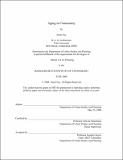Aging in community
Author(s)
Fay, Justin (Justin Thomas)
DownloadFull printable version (10.73Mb)
Other Contributors
Massachusetts Institute of Technology. Dept. of Urban Studies and Planning.
Advisor
John de Monchaux.
Terms of use
Metadata
Show full item recordAbstract
Baby Boomers are on the brink of retirement. According to U.S. Census Bureau projections, the number of people aged 65 and over will more than double in the coming decades, growing from 35 million in 2000 to 72 million in 2030. The current housing stock in the United States is incapable of accommodating the particular needs and demands of this burgeoning population of older adults. In the next decade, many seniors will move from their homes into new environments, ranging from independent living communities to assisted living facilities and nursing homes, each offering a different level of support and range of services. In recent years, a more comprehensive option for seniors seeking long-term housing has grown in popularity -- the Continuing Care Retirement Community (CCRC). CCRCs encourage active independence while offering a continuum of care options from short-term rehabilitation to long-term care services. Physical, sensory, and/or cognitive abilities commonly decline with age. CCRCs meet these changing health care needs in one location, enabling an individual to age -- dignity and sense of belonging intact -- within the community, thereby precluding the need to relocate and adapt to a new setting. This research investigates the performance of the CCRC model as an approach to housing the growing population of seniors. What has been the experience of these communities to date, and what can be learned from them that might influence their planning, design, and management in the future? Specifically, in what ways do CCRCs connect residents, both socially and physically, to the people, facilities, and services that comprise community? (cont.) Two case studies located in the Greater Boston area -- one a large, privately developed and managed community, the other a comparatively small, college-affiliated community -- are analyzed to identify successes and limitations. This analysis leads to a set of "good practices" aimed at improving senior housing such that an aging population can thrive and age in one place.
Description
Thesis (M.C.P.)--Massachusetts Institute of Technology, Dept. of Urban Studies and Planning, 2008. This electronic version was submitted by the student author. The certified thesis is available in the Institute Archives and Special Collections. Includes bibliographical references (p. 101-103).
Date issued
2008Department
Massachusetts Institute of Technology. Department of Urban Studies and PlanningPublisher
Massachusetts Institute of Technology
Keywords
Urban Studies and Planning.